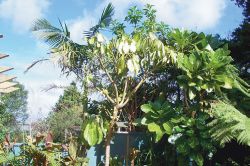Plant
Doctor Archive
Ailing
puka 
 I
HAVE a mature puka that appears to be dying. The one adjacent to
it and other surrounding plants are all healthy. We are on the side
of a gently sloping hill and drainage doesn't appear to be a problem.
I would be grateful of any advice. I
HAVE a mature puka that appears to be dying. The one adjacent to
it and other surrounding plants are all healthy. We are on the side
of a gently sloping hill and drainage doesn't appear to be a problem.
I would be grateful of any advice.
 IT'S
difficult to tell from your photo exactly what the problem is, so
here are a few tips to help you investigate further. IT'S
difficult to tell from your photo exactly what the problem is, so
here are a few tips to help you investigate further.
Yellowing and drooping
of leaves like this is usually the result of the tree's inability
to send water and nutrients from the roots up to the leaves. This
can be caused in several ways. Root disease is one, but you say
the area is relatively free-draining. I wouldn't discount root disease
altogether, though, and if none of the other ideas I mention pan
out, you could dig in the soil a little way out from the base of
the tree and look for healthy or rotten roots.
Collar rot is the next
possibility. Look around the base of the trunk and check the condition
of the bark - it should look firm and healthy, with no cracks or
open wounds. Collar rot can occur if you lay mulch hard up against
the trunks of some trees and shrubs. The wet mulch provides an ideal
environment for rot-causing diseases to get established in the bark
and, if severe enough, they can kill a tree, with symptoms appearing
much like those in your photo.
Next, I'd work my way
up the trunk and branches looking for open wounds. Believe it or
not, pukas can be subject to quite vicious attack by rats. At certain
times of year they're attracted to the sweet sugary sap and can
chew large holes in stems and branches of quite mature pukas. If
enough of the vascular system is destroyed, the tree could exhibit
symptoms very much like yours.
Weekend
Gardener, Issue 180, 2005, Page 32
Reproduced with permission from the former Weekend Gardener magazine. The views expressed here are not necessarily those of the RNZIH.
|
 |
 |
|